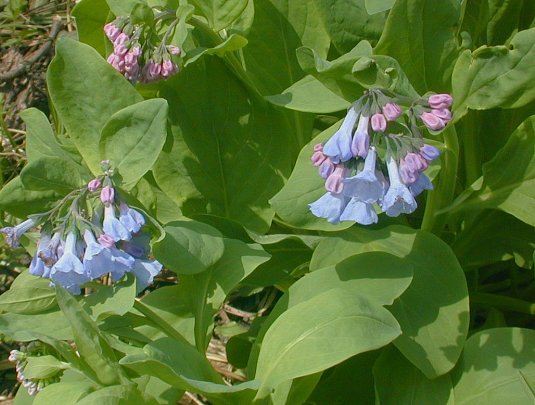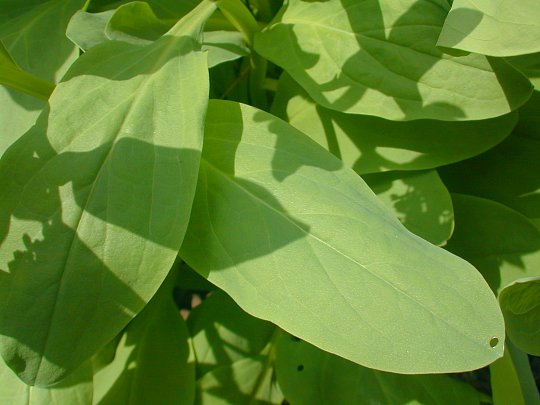Description: This herbaceous perennial plant is 1–2½' tall, branching occasionally. The central stem is terete, hairless, and usually light green (less often purplish green or purple). The alternate leaves are up to 7" long and 3½" across. They are light green or greyish green and hairless with a soft floppy texture. The leaves are ovate-oval or ovate-oblong in shape, smooth (entire) along their margins, and pinnately veined. The leaves usually taper to winged petioles up to 2½" long, although some of the upper leaves are sessile. The upper stems terminate in nodding cymes of flowers. Individual flowers are about ¾–1¼" in length.

The corolla of
each flower is tubular at its base, but it is
more bell-shaped (campanulate) toward its outer rim, where there are 5
shallow lobes that are barely discernible. Inserted within the corolla,
there are 5 white stamens with light brown anthers and a white style
that is long and slender. The small greyish green calyx of each flower
is about ¼" (6 mm.) long; it is divided into
5 elliptic teeth. The flower buds are pink, bluish pink, or
purple, while the
corollas of mature flowers are light blue (rarely white or pink).
The pedicels of the flowers are greyish green to purple,
terete, and up to ¼" (6 mm.) long.
The blooming period occurs from mid- to late spring, lasting about
3 weeks. Afterwards, the flowers are replaced by 4-lobed fruits
(schizocarps), which contain the nutlets (4 nutlets per
flower). The small nutlets are dark brown, ovoid, and flattened on one
side; their surfaces are minutely wrinkled or pitted. The root system
consists of a taproot. This plant often forms colonies.
Cultivation:
The preference is light shade to partial sun in moist areas with
rich loamy soil. This plant develops very quickly during the spring
after danger of hard frost has passed. Its foliage dies
down by mid-summer.

Range &
Habitat:
Virginia Bluebells is a fairly common plant that occurs in most
counties of Illinois (see Distribution
Map),
where it is native. Habitats include floodplain woodlands, bottomland
woodlands, mesic woodlands, and wooded bluffs. Sometimes this
wildflower forms sizable colonies in semi-shaded floodplain areas
along rivers or streams, where it often competes with Wood Nettle (Laportea canadensis).
It is also cultivated in flower gardens.
Faunal Associations:
The flowers are cross-pollinated by long-tongued bees primarily,
including honeybees, bumblebees, Anthophorid bees (Anthophora spp., Synhalonia spp.),
and mason bees (Osmia
spp.); these insects obtain nectar and/or collect
pollen. Other visitors of the flowers include the Giant Bee Fly (Bombylius major),
butterflies, skippers, and Sphinx moths, including a hummingbird moth (Hemaris thysbe).
This group of visitors suck nectar from the flowers. Halictid bees and
Syrphid flies sometimes visit the flowers, but they are too small in
size to be effective pollinators. In some areas, the
Ruby-Throated Hummingbird has been observed to visit the flowers.
White-Tailed Deer
browse on the foliage occasionally during the spring. When this plant
forms large colonies, it provides protective cover for many kinds of
wildlife during the spring.

Photographic
Location:
A moist wooded area of Busey Woods in Urbana, Illinois.
Comments:
It is easy to see why Virginia Bluebells (Mertensia virginica)
is a favorite woodland wildflower. The pastel colors of the flowers and
foliage are soft and soothing. There are other Mertensia spp.
in the United States with a similar appearance, but they occur north or
west of Illinois. They usually have smaller flowers and/or pubescent
foliage.